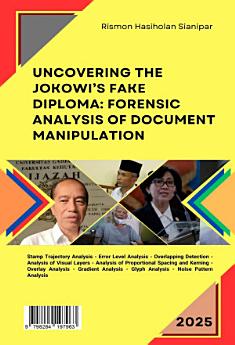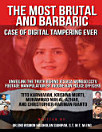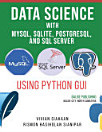Uncovering the Jokowi’s Fake Diploma: Forensic Analysis of Document Manipulation
About this ebook
Beyond traditional examination, digital forensic techniques can detect subtle signs that a document, though seemingly analog, may originate from a digital creation process. Misaligned characters, inconsistent line spacing, or attempts to mimic aged printing through computer-generated outputs can all serve as indicators of forgery. Comparing suspect documents with authentic reference materials enables experts to ascertain the legitimacy of a document, even in cases where reprinting or photocopying attempts have been made to obscure tampering.
This book explores the application of advanced forensic methodologies, such as stamp trajectory analysis, Error Level Analysis (ELA) with CLAHE, Local Binary Pattern (LBP) analysis, and K-Means Color Clustering. These methods were applied to examine high-profile cases, including the authentication of diplomas and thesis approval sheets. Through multi-layered analyses, variations in ink intensity, compression profiles, letter overlapping, and text-background interactions were identified, revealing evidence of digital manipulation or reproduction in certain documents, while distinguishing authentic prints produced through conventional methods.
Furthermore, cutting-edge techniques like Multi-Scale Gradient Analysis, ORB feature detection, template matching, and Noise Pattern Analysis (NPA) were utilized to investigate micro-patterns, letter geometry, and printing technology. These approaches not only confirmed inconsistencies in allegedly manual prints but also provided objective metrics that support forensic conclusions. By combining visual, textural, and numerical evidence, these methodologies demonstrate the robustness of digital forensics in uncovering manipulations, even when documents appear superficially authentic.
This book aims to provide readers with a comprehensive understanding of the capabilities and significance of forensic document analysis. Through detailed case studies and methodical exploration of both analog and digital authentication techniques, it highlights the importance of forensic typography, imaging, and texture analysis in modern investigative practice. The integration of scientific rigor and innovative technological approaches underscores the essential role of digital forensics in ensuring document authenticity and supporting the pursuit of truth in legal and academic contexts.
Ratings and reviews
- Flag inappropriate
- Flag inappropriate
- Show review history
About the author
Rismon Hasiholan Sianipar, born in Pematang Siantar in 1994, is a distinguished researcher and expert in the field of electrical engineering. After completing his education at SMAN 3 Pematang Siantar, Rismon ventured to the city of Jogjakarta to pursue his academic journey. He obtained his Bachelor of Engineering (S.T) and Master of Engineering (M.T) degrees in Electrical Engineering from Gadjah Mada University in 1998 and 2001, respectively, under the guidance of esteemed professors, Dr. Adhi Soesanto and Dr. Thomas Sri Widodo. During his studies, Rismon focused on researching non-stationary signals and their energy analysis using time-frequency maps. He explored the dynamic nature of signal energy distribution on time-frequency maps and developed innovative techniques using discrete wavelet transformations to design non-linear filters for data pattern analysis. His research showcased the application of these techniques in various fields. In recognition of his academic prowess, Rismon was awarded the prestigious Monbukagakusho scholarship by the Japanese Government in 2003. He went on to pursue his Master of Engineering (M.Eng) and Doctor of Engineering (Dr.Eng) degrees at Yamaguchi University, supervised by Prof. Dr. Hidetoshi Miike. Rismon's master's and doctoral theses revolved around combining the SR-FHN (Stochastic Resonance Fitzhugh-Nagumo) filter strength with the cryptosystem ECC (elliptic curve cryptography) 4096-bit. This innovative approach effectively suppressed noise in digital images and videos while ensuring their authenticity. Rismon's research findings have been published in renowned international scientific journals, and his patents have been officially registered in Japan. Notably, one of his patents, with registration number 2008-009549, gained recognition. He actively collaborates with several universities and research institutions in Japan, specializing in cryptography, cryptanalysis, and digital forensics, particularly in the areas of audio, image, and video analysis. With a passion for knowledge sharing, Rismon has authored numerous national and international scientific articles and authored several national books. He has also actively participated in workshops related to cryptography, cryptanalysis, digital watermarking, and digital forensics. During these workshops, Rismon has assisted Prof. Hidetoshi Miike in developing applications related to digital image and video processing, steganography, cryptography, watermarking, and more, which serve as valuable training materials. Rismon's field of interest encompasses multimedia security, signal processing, digital image and video analysis, cryptography, digital communication, digital forensics, and data compression. He continues to advance his research by developing applications using programming languages such as Python, MATLAB, C++, C, VB.NET, C#.NET, R, and Java. These applications serve both research and commercial purposes, further contributing to the advancement of signal and image analysis. Rismon Hasiholan Sianipar is a dedicated researcher and expert in the field of electrical engineering, particularly in the areas of signal processing, cryptography, and digital forensics. His academic achievements, patented inventions, and extensive publications demonstrate his commitment to advancing knowledge in these fields. Rismon's contributions to academia and his collaborations with prestigious institutions in Japan have solidified his position as a respected figure in the scientific community. Through his ongoing research and development of innovative applications, Rismon continues to make significant contributions to the field of electrical engineering.






